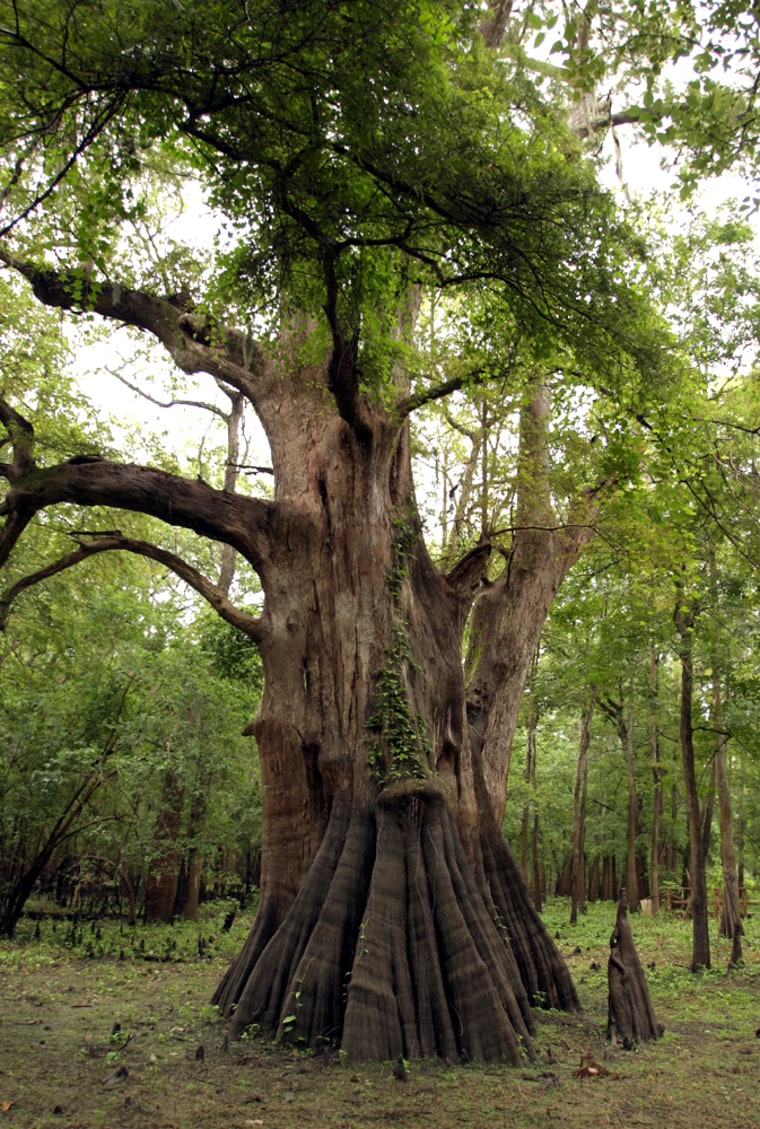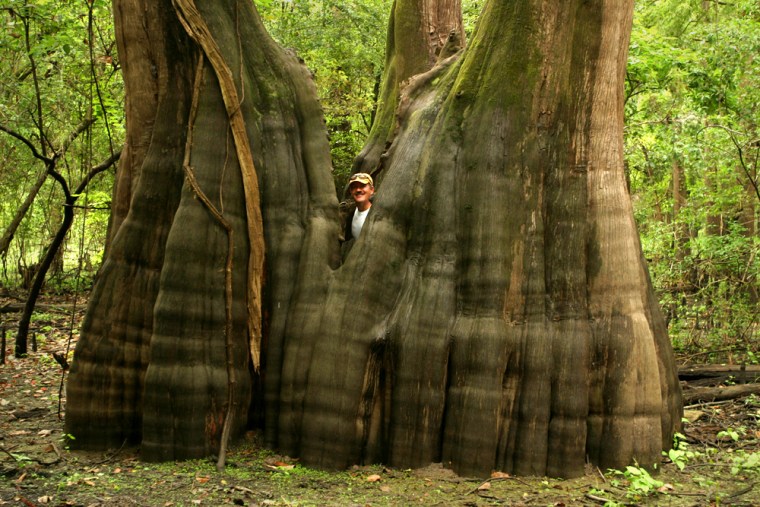A tree can inspire awe better than any man-made structure, particularly one that has eclipsed its brethren and thumbed its “knees” at man’s efforts to turn it into something useful. On Day 12 of our two-week journey down the Mississippi River, we came face-to-trunk with one such forest monarch and met some locals who, while they have very different perspectives on the best uses for trees, share a deep love for a special piece of Louisiana swamp.
We caught up with Keith Ouchley early on an unseasonably cool and drizzly day in St. Francisville, a tourist town in Louisiana’s West Feliciana Parish. After making introductions, we set out in his pickup truck for Cat Island, a poorly named peninsula surrounded on three sides by the Mississippi River.
Ouchley (pronounced OOCH-lee), the executive director of the Nature Conservancy of Louisiana, had graciously agreed to act as our guide on a tour of the 10,000-acre Cat Island National Wildlife Refuge, one of the only remaining expanses of the bottomland hardwood forest that hasn’t been “disconnected” from the river by levees. As a result, Cat Island is flooded to a depth of 10 to 12 feet each winter and typically remains underwater until April or May.
As his crowning act of kindness, the 45-year-old conservationist had offered to introduce us to the champion bald cypress – the largest member of its species and the biggest tree east of California’s Sierra Nevada range.
We had been dying to lay eyes on the great bald cypress ever since reading “The Mississippi and the Making of a Nation” by Stephen Ambrose and Douglas Brinkley. In it, the historians described a similar hike with Ouchley two years ago and their inability to put the tree’s majesty to words.
“At last, there it was, the champion bald cypress, its base large enough for 50 people to hug at once,” they wrote. “… Its heavy limbs came in all sizes and shapes, too surreal to describe in words. We took some photographs, none of which did the tree justice.”
Despite our eagerness, Ouchley suggested we first pay a call on a couple of characters who know the Cat Island swamp as intimately as any human can. After first venturing up to a remote house by himself to see if the pair was up to receiving a couple reporters, he reappeared and waved us up.
A few minutes later we were seated on the front porch of a cozy but weather-beaten house, sharing a cup of coffee with brothers “Dump” and “Moochie” Metz.
The Metzes were born on the edge of the swamp more than seven decades ago and haven’t ever ventured far from its moist embrace. By the end of our 45-minute conversation, they had us believing that there could be no finer place to live – bugs, heat, floods and all.
They described an idyllic existence growing up in a family of six brothers and two sisters on the family’s isolated spread of land about 6 miles west of St. Francisville.
“We were the … onliest ones on the creek road,” said 76-year-old “Moochie,” who is on rare occasions addressed by his Christian name, Julius.
“We just had a good time when we growed up,” added “Dump,” a 71-year-old live wire whose given name is Carl. “We didn’t know nothing about no drug or nothing like they do now. We spent all our time in that swamp.”
When they weren’t hunting, fishing, trapping or having campouts with their school chums, they were helping their father, Jesse, raise cattle and harvest cypress trees from the swamp.
“We called ourselves farmers, but we made shingles, hard-cypress singles for roofs,” Dump recalled.
Father and sons would often cut down the trees in the winter and spring, when the river floods the swamp, and then float them to their workshop or a sawmill downriver.
Dump once told Ouchley that the Metz clan likely would have cut down the champion bald cypress as “a snag” if it had been more conveniently placed, since the tree is hollow – as are all members of the species that make it to an advanced age – and was of no use for shingles.
While the Metzes cut their share of timber over the years, theirs was always a small-scale operation that left no permanent scars on Cat Island.
They can’t say the same for the Army Corps of Engineers, which in the late 1960s dug a canal into the peninsula in an effort to drain it so that it could be used for farming. Though the project was abandoned out of fears that the Mississippi would alter its course and overrun the canal, the Metzes say it still causes the swamp to drain much faster than it used to.
“Swamp ain’t no good without water,” said Dump. “… A beaver got more sense than some of these engineers.”
At the end of a laughter-filled conversation – enlivened by such tales as Moochie’s fall into the “slicker box” – a container used to store the rotten fish used as crawfish bait – we said goodbye to the Metz brothers and resumed our drive to the swamp and our rendezvous with the great bald cypress.
As he drove, Ouchley explained that plantation owners in the 1830s or ‘40s had attempted to put Cat Island to agricultural use by building levees to prevent it from flooding. They, too, were thwarted when the Mississippi and tributaries that feed the swamp repeatedly washed out the earthen barrier.
Attempts to mount major logging operations in the forest also went nowhere, because of the annual flooding.
The Nature Conservancy was able to purchase the property from Georgia-Pacific four years ago and last year transferred it to the U.S. Fish and Wildlife Service for use as a National Wildlife Refuge. The acquisition was just one piece of the environmental organization’s efforts to preserve and restore the Mississippi River watershed through projects designed to benefit the entire river system, such as flood-plain restoration and the restoration of backwater lake systems.
“Cat Island has dodged the bullet and that’s good for everyone,” Ouchley said. “The result is the highest density of bald cypress anywhere that we know of.”
The refuge also is a haven for wildlife -- including the threatened Louisiana black bear, white-tailed deer, bobcat, mink, river otter, wild turkey and the green tree frog -- and an important concentration of habitat for neotropical migratory songbirds and other fowl, he said.
After entering the wildlife refuge, which is in the center of the 35,000-acre peninsula, we came upon a crew replacing a culvert and had an hour to kill before the road would reopen. We took advantage of the down time to explore a nearby hiking trail and get our first close look at the bald cypress trees.
In addition to the fluted trunks that give the older cypress trees their distinctive corduroy appearance, the trees have another distinguishing feature that sets them apart from other species – “knees.”

“Cypress knees … are protrusions off the roots that may stick up 2, 3 … 6, 7 feet in the air, which form little groups around the bases of the trees,” Ouchley said. “… It has never been proved what those knees are out there for. It’s thought to be increased oxygen support for the roots. It’s (also) thought to help buttress the trees against movement at times when the soil is drying out.”
The gnarled knees add immensely to the mystical atmosphere in the forest, looking like acolytes huddling around a larger-than-life priest.
With increasing sunshine beginning to penetrate the canopy of bald cypress, water tupelo, overcup oak and bitter pecan trees, among others, we returned to Ouchley’s truck, made our way over the newly replaced culvert and drove to the parking lot at the head of the trail to the champion bald cypress.
As we started down the trail for the short hike to the tree, Ouchley explained that the champion tree earned its title via a formula that adds circumference (53 feet), height (around 90 feet) and maximum crown spread (65 feet is my wild guess) and then divides the total by three. Since the trees hollow out as they get older, providing excellent burrows for a variety of wildlife, it’s impossible to determine their age by taking a core sample. But experts believe that the champion bald cypress is between 700 years and over 1,000 years old, Ouchley said.
No sooner had he finished describing the giant than we saw it – a twin-trunked wonder thrusting up from a base wide enough to stage foot races around if it hadn’t been fenced off to protect against soil compaction from too many visitors coming to pay homage.

As have others before us, we found ourselves dumbstruck as we gazed up at its long, needle-covered branches outlined against the blue sky, a condition that Ouchley confessed to sharing despite having seen the tree hundreds of times now.
“I don’t know how you explain a cypress tree,” he said. “It’s one of those things you have to see.”
He had better luck explaining why he loves to come and walk through the forest.
“I feel a connection to these trees because (they) were there 400, 500 years ago,” he said. “… There are extremely few places I know that you can touch that history, feel that history and get a glimpse of what it must have been like when (early European explorers) La Salle, Bienville, Iberville and de Soto came through this part of the world hundreds of years ago.”
After driving back to St. Francisville and making a brief stop at the St. Francisville Inn to admire photos of the swamp taken by proprietor Pat Walsh, we piled back into our van and headed south to the Big Easy – New Orleans.
On Day 13 of our journey, we will meet with shipyard owner Donald “Boysie” Bollinger, who keeps the river traffic flowing with his ship-building and repair operations.
Reporter and media producer Jim Seida are traveling the length of the Mississippi in August and will be filing daily dispatches along the way. If you have a question or comment, mail us at mississippi@msnbc.com.